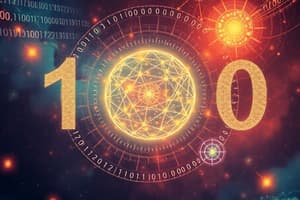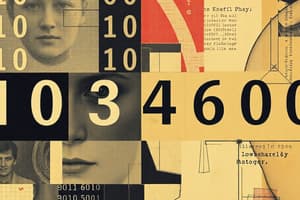Podcast
Questions and Answers
What is the octal representation of the binary number (110010011)₂?
What is the octal representation of the binary number (110010011)₂?
- (573)₈
- (623)₈ (correct)
- (625)₈
- (704)₈
How is the decimal number (428)₁₀ converted to hexadecimal?
How is the decimal number (428)₁₀ converted to hexadecimal?
- 1B4
- 1A4
- 1AE
- 1AC (correct)
Which of the following is the correct conversion of (E29)₁₆ to binary?
Which of the following is the correct conversion of (E29)₁₆ to binary?
- (1110 | 0101 | 1000)₂
- (1111 | 0001 | 1000)₂
- (1101 | 0010 | 1100)₂
- (1110 | 0010 | 1001)₂ (correct)
What is the decimal value of the hexadecimal number (3AB4)₁₆?
What is the decimal value of the hexadecimal number (3AB4)₁₆?
What is the result when converting the binary number (01011111)₂ to hexadecimal?
What is the result when converting the binary number (01011111)₂ to hexadecimal?
What is the smallest unit of data that a binary computer can recognize?
What is the smallest unit of data that a binary computer can recognize?
How many bits are there in one byte?
How many bits are there in one byte?
Which numbering system uses only the symbols 0 and 1?
Which numbering system uses only the symbols 0 and 1?
Which of the following represents a grouping of 1,024 bytes?
Which of the following represents a grouping of 1,024 bytes?
What is the base of the decimal numbering system?
What is the base of the decimal numbering system?
In digital data representation, how is the position of digits significant?
In digital data representation, how is the position of digits significant?
Which of these is NOT a prefix used for data size?
Which of these is NOT a prefix used for data size?
To a digital computer, how do letters and punctuation marks appear?
To a digital computer, how do letters and punctuation marks appear?
What is the binary equivalent of the decimal number 13?
What is the binary equivalent of the decimal number 13?
Which of the following represents the number 21 in decimal using binary notation?
Which of the following represents the number 21 in decimal using binary notation?
What is the decimal equivalent of the octal number (345)₈?
What is the decimal equivalent of the octal number (345)₈?
How is the octal number (725)₈ represented in binary?
How is the octal number (725)₈ represented in binary?
What base does the octal number system use?
What base does the octal number system use?
To convert from decimal to octal, which method is typically used?
To convert from decimal to octal, which method is typically used?
What is the value of the binary number 0101₂ in decimal?
What is the value of the binary number 0101₂ in decimal?
Study Notes
Number Systems Overview
- Four primary numbering systems: Decimal, Binary, Octal, Hexadecimal.
- Each uses different bases: Decimal (10), Binary (2), Octal (8), Hexadecimal (16).
Decimal Number System
- Utilizes 10 symbols: {0, 1, 2, 3, 4, 5, 6, 7, 8, 9}.
- Each digit's position represents powers of 10.
- Example: 1325₁₀ = (1x10³) + (3x10²) + (2x10¹) + (5x10⁰).
Binary Number System
- Base is 2, employing symbols 0 and 1.
- Each binary digit's position represents powers of 2.
- Example: 10101₂ = (1x2⁴) + (0x2³) + (1x2²) + (0x2¹) + (1x2⁰) = 21₁₀.
Octal Number System
- Base is 8, using symbols {0, 1, 2, 3, 4, 5, 6, 7}.
- Each octal digit equates to powers of 8.
- Example: (345)₈ = (3x8²) + (4x8¹) + (5x8⁰) = 229₁₀.
Hexadecimal Number System
- Base is 16, consisting of 16 symbols: {0, 1, 2, 3, 4, 5, 6, 7, 8, 9, A, B, C, D, E, F}.
- Each digit is weighted by powers of 16.
- Example: (3AB4)₁₆ = 3x16³ + 10x16² + 11x16¹ + 4x16⁰ = 15028₁₀.
Conversion Methods
- Binary to Octal: Group binary digits into sets of three; e.g., (110 | 010 | 011)₂ = (623)₈.
- Binary to Hexadecimal: Group binary digits into sets of four; e.g., (0101 | 1111 | 1010 | 0110)₂ = (5FA6)₁₆.
- Octal to Decimal: Multiply and sum based on position; e.g., (725)₈ = 7x8² + 2x8¹ + 5x8⁰.
- Decimal to Octal: Repeated division by 8.
- Hexadecimal to Decimal: Multiply and sum based on power of 16.
- Hexadecimal to Binary: Expand each digit into four binary digits; e.g., (E29)₁₆ = (1110 0010 1001)₂.
Digital Data Representation
- Digital computers use binary (0 and 1) to represent all data.
- Bit: Smallest data unit (0 or 1); Byte: 8 bits.
- File sizes expressed in larger units: KB, MB, GB, TB, PB, EB, ZB, YB.
Importance of Numbering Systems
- Computers interpret all data (numbers, letters, sounds, images) as binary forms of numbers.
- Example: The text "Here are some words" converted into binary representation for computer processing.
Key Binary Representations
- Decimal Numbers and their Binary Equivalents:
- 0: 0000
- 1: 0001
- 2: 0010
- 3: 0011
- 4: 0100
- 5: 0101
- 6: 0110
- 7: 0111
- 8: 1000
- 9: 1001
- 10: 1010
- 11: 1011
- 12: 1100
- 13: 1101
- 14: 1110
- 15: 1111
Summary of Key Concepts
- Mastering conversions among different numbering systems is crucial for understanding digital data representation in computing.
- Familiarity with basic data units and their binary counterparts provides a foundation for programming and digital data handling.
Studying That Suits You
Use AI to generate personalized quizzes and flashcards to suit your learning preferences.
Related Documents
Description
Test your knowledge on number systems, including binary, octal, and hexadecimal conversions. This quiz covers the principles of converting between different bases and understanding their representations. Sharpen your mathematical skills through practical examples and calculations.




